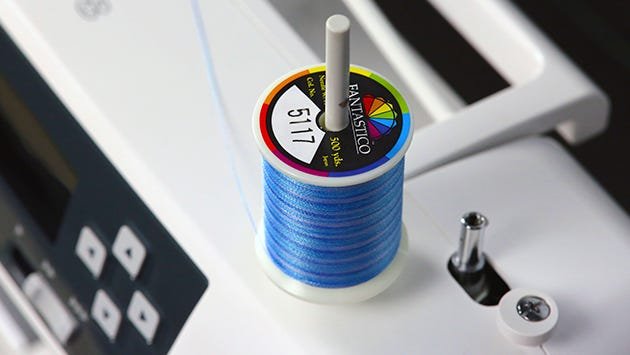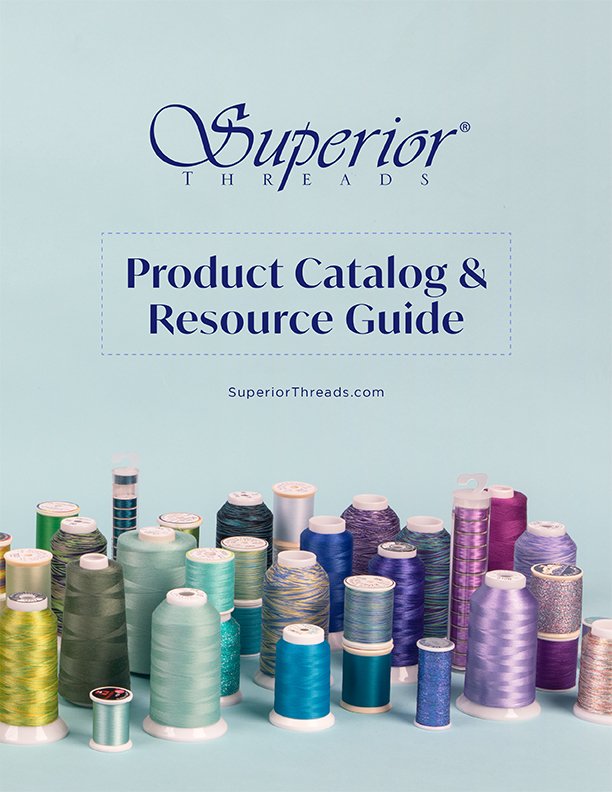Superior Education
THREAD CHARACTERISTICS
- THREAD WEIGHT
- FIBER TYPES
- THREAD PROCESSING
Thread Construction Methods
The higher the quality of the thread, the less special handling will be required. Poor quality thread has much lint and breaks easily and can take the joy out of any sewing project. Each type of thread has specific characteristics and will behave differently on sewing machines. Threads are either made of a natural fiber (cotton, wool, silk, linen) or synthetic fibers (rayon, polyester, nylon). While there are dozens of fiber types that could be twisted and spun into thread, there are a handful of common fibers that are used in sewing, quilting, serging, and embroidery.
- Spun thread - Cotton or polyester staple fibers are spun into single yarns and then twisted together.
- Corespun thread - Spun cotton or polyester staple fibers are wrapped around filament polyester fibers.
- Textured thread - Polyester or nylon that has been mechanically textured to make the thread fuzzy and stretchy and woollie-like. Texturing is a procedure used to increase the volume and the elasticity of a filament yarn. The essential properties of textured yarns and the products made from them are softness, fullness, a high degree of elasticity, thermal insulation and moisture-transporting properties.
- Filament thread - Shiny thread made of strands of polyester, rayon, or nylon.
- Monofilament thread - A single nylon or polyester filament. Polyester is highly preferred.
- Bonded thread - A strength-enhancing resin is coated on the outside of the thread. This increases the tensile strength and helps reduce friction. Bonded threads are usually meant for upholstery and heavy duty sewing applications.

Fantastico is a high-strength trilobal polyester thread

King Tut is nature's finest cotton thread
Thread Types
Cotton
Cotton threads are made from twisting the fine staples (fibers) from a cotton bowl to create a thread. There are many degrees of cotton quality. Superior's cotton threads are made from Egytpitan-grown extra-long-staple cotton fibers. The advantages of cotton threads are: its strength, medium sheen, and the natural fibers help grab the fabric to create a tight seam. The disadvantages of cotton threads are: difficult to tell low-quality from high-quality (purchasing thread from a reputable company helps alleviate this risk), low-to-high lint depending on the staple length and processing, and quality cotton threads can be more expensive.
Corespun Polyester (also called poly-wrapped poly core)
Corespun polyester threads have a filament polyester core that is wrapped with spun polyester. The advantages of corespun polyester threads are: its strength, reduced puckering, and excellent stitchability. The disadvantages of corespun polyester threads are: low-to-moderate lint.
Filament Polyester
Filament polyester threads are made from long, thin strands of polyester fibers that are twisted together. The advantages of filament polyester threads are: excellent elongation (the fibers can stretch and recover), smooth presence with no lint and can be finished as a thick or thin thread. The disadvantages of filament polyester threads are: not as strong as corespun (when comparing the same size of thread) and finer filament threads may require tension adjustments.
Monofilament Polyester
Monofilament polyester threads are a single strand of polyester fiber, similar to fishing line. The advantages of monofilament polyester threads are: it's usually a very fine thread that blends very well and can be ironed on medium heat. The disadvantages of monofilament polyester threads are: tension adjustments are usually required when quilting.
Spun Polyester
Spun polyester threads are made from the twisting of small polyester staple fibers together to create a long thread (very similar to how cotton threads are created from cotton staples). The advantages of spun polyester threads are: spun polyester threads are less expensive to produce and are usually priced lower than any other type of polyester thread. The disadvantages of spun polyester threads are: moderate-to-high levels of lint when sewing and not as strong as filament or corespun polyester threads.
Rayon
Rayon is created by pressing cellulose acetate (usually made from wood pulp) through small holes and solidifying it in the form of filaments (sound like fun!). The advantages of rayon threads are: its high-sheen colors, its soft touch, and it's an inexpensive thread. The disadvantages of rayon threads are: it's often not colorfast (the dye can bleed onto fabric when exposed to strong detergent, UV light, or bleach), it's not as strong as trilobal polyester, and the fiber itself is not as durable as polyester.
Nylon
Nylon threads are synthetic threads (polyester threads are synthetic as well) often used in the form of a monofilament clear thread or as a textured fuzzy (woollie-like) thread. The negatives far outweigh the positives of nylon. We do not recommend sewing or quilting with nylon threads, as there are better versions for the same application in polyester threads. The only type of Nylon thread we use and recommend is Bonded Nylon for upholstery and heavy-duty sewing. Bonded Nylon is made from a different type of material than nylon sewing thread. We don't use nylon for quilting or embroidery.
Metallic
Metallic threads are created from multiple layers of materials wrapped and twisted together. The quality of metallic threads range from very high to very low. A good metallic thread does not require a lubricant. Superior's metallic threads have a strong nylon core, a thin layer of rice paper and a special outer coating that keeps the silver foil from rubbing against the needle. The advantages of Superior's metallic thread is: beautiful sheen and excellent stitch quality when embroidered, quilted, or sewn. The disadvantages of metallic thread is: tension adjustments are required and stitching speed may need to be decreased.
Glitter or Mylar
Mylar threads are created by bonding thin layers of flat mylar material. The advantages of Glitter thread is: holographic effect and can be embroidered, quilted, or sewn. The disadvantages of Glitter thread is: tension adjustments are required and stitching speed may need to be decreased.

Thread Processing
All sewing and quilting thread undergo some of the same processing, such as twisting, lubricating, winding, etc. Cotton threads however, can have additional processing to enhance the stitching experience.
Mercerized
Mercerization is the process of immersing the cotton fibers in a caustic solution which causes the fibers to swell. This allows the dye to better penetrate the fibers and increases the luster of the thread. Mercerizing also increases the strength of the cotton thread. Nearly all cotton threads made for sewing all mercerized, whether the label states Mercerized or not.
Gassed
Thread that has been gassed is smoother, has lower lint, and a brighter sheen. The thread is passed through a flame at high speed to burn off the longest pieces of lint, resulting in a less fuzzy thread. Gassing is also called silk finish or polished cotton. You can tell the difference between a gassed and ungassed thread if you compare the amount of fuzz (lint) between the two threads. Our King Tut and MasterPiece cotton threads are gassed and have very low lint.
Glazed or Coated
Glazed thread is treated with a coat of wax, resin, or starch and then polished to create a nice luster. The thread is very strong due to the glaze and is recommended for hand quilting. Glazed cotton threads are not recommended for machine sewing or machine quilting because the coating can rub off in the tension discs and contact points and collect lint, fuzz, dust, and cause a buildup to obstruct the thread path.

 View Our Product Catalog
View Our Product Catalog